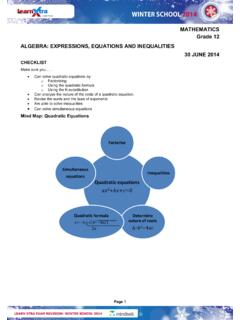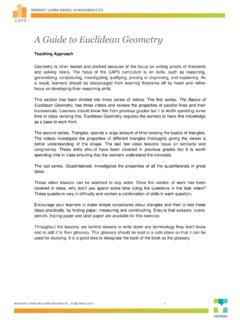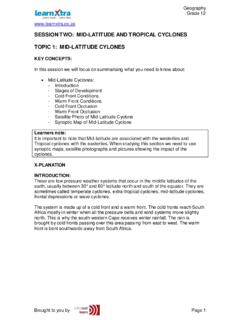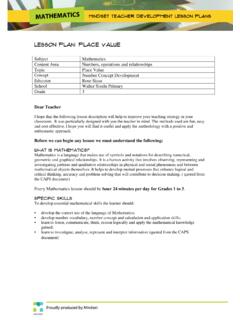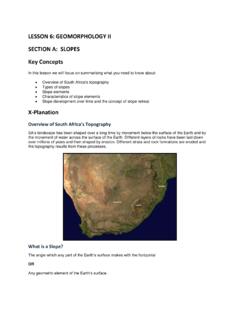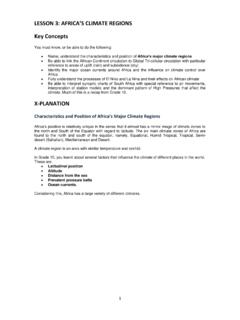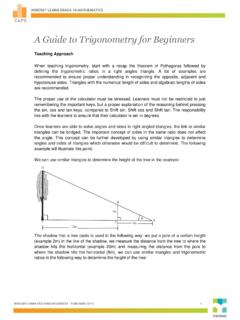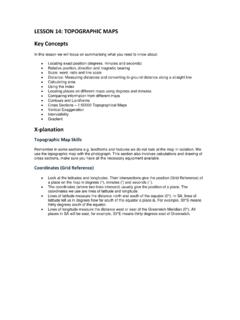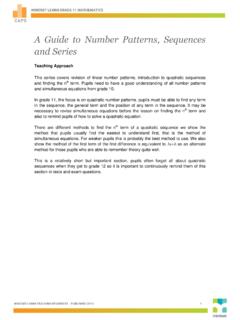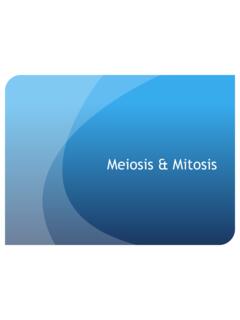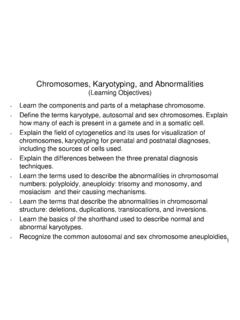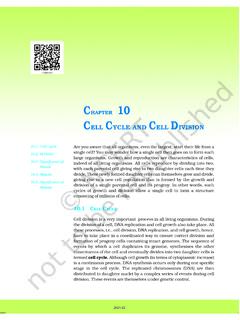Transcription of LIFE SCIENCES Grade 12 MEIOSIS 02 JULY 2014
1 LIFE SCIENCES Grade 12 Page 1 MEIOSIS 02 JULY 2014 Checklist Make sure you .. Review the structure of a cell with an emphasis on the parts of the nucleus, the centrosome and the cytoplasm Know that chromosomes are made up of DNA Know your terminology. Differentiate between: o Haploid (n) and diploid (2n) cells in terms of chromosome number o Sex cells (gametes) and somatic cells (body cells) o Sex chromosomes (gonosomes) and autosomes Revise the process of mitosis . Can define MEIOSIS Are able to link Interphase in MEIOSIS with DNA replication.
2 Single-stranded chromosomes become double stranded. Each chromosome will now consist of two chromatids joined by a centromere. DNA replication helps to double the genetic material so that it can be shared by the new cells arising from cell division Can describe and identify the following phases in MEIOSIS I o Prophase I crossing over o Metaphase I o Anaphase I o Telophase I Are able to describe and identify the following phases in MEIOSIS II o Prophase II o Metaphase II o Anaphase II o Telophase II Can compare the processes of MEIOSIS and mitosis .
3 Tabulate the similarities between mitosis and MEIOSIS and the differences Can state the importance of MEIOSIS with regard to each of the following: o Production of gametes o Halving of the chromosome number (diploid to haploid) o Mechanism to introduce genetic variation through: Crossing over The random arrangement of chromosomes at the equator Understand that sometimes abnormal MEIOSIS occurs and what the consequences are: State what is meant by non-disjunction. State the consequences of non-disjunction.
4 Describe how non-disjunction of chromosome pair 21 in humans leads to the formation of an abnormal gamete with an extra copy of chromosome 21. Describe how the fusion between the abnormal gamete and a normal gamete may lead to Down syndrome. Remember to link MEIOSIS to REPRODUTION, GENETICS and EVOLUTION LIFE SCIENCES Grade 12 Page 2 Exam Questions Question 1 (Adapted from Feb/March 2011, Paper 1, Question 2) Study the following diagrams representing different phases of MEIOSIS . Label structures A, B and C.
5 (3) Which phase is represented by: a. Diagram 1 b. Diagram 2 (2) Write down the numbers of the diagrams to show the correct sequence in which the phases occur. (4) Tabulate THREE differences between the first and second stages of MEIOSIS . (7) Name and explain TWO processes/mechanisms that ensure that the gametes produced at the end of MEIOSIS are genetically different from each other. (4) Question 2 (Adapted from Nov 2009, Paper 1, Question 1) The diagram below represents an animal cell in a phase of MEIOSIS .
6 LIFE SCIENCES Grade 12 Page 3 State which phase of MEIOSIS is represented in the diagram above. (1) Give a reason for your answer to QUESTION (2) Identify parts A and B. (2) How many chromosomes .. (a) were present in the parent cell before it underwent MEIOSIS ? (1) (b) will be present in each cell at the end of the meiotic division? (1) State ONE place in the body of a human female where MEIOSIS would take place. (1) Could the cell represented in the diagram be that of a human?
7 (1) Explain your answer to QUESTION (2) Give TWO reasons why MEIOSIS is biologically important. (2) Question 3 (Adapted from IEB Nov 2012, Paper 1, Question 2) The inclusion of extra chromosomes in gametes occurs far more often in the formation of egg cells than in sperm cells. The karyotype below shows the chromosomes of an individual from an egg cell with an extra chromosome number 21. What is the name for the disorder caused by the inclusion of an extra chromosome 21? (1) State ONE phenotypic result in an individual with this abnormality.
8 (1) This karyotype is useful for studying the chromosomes of an individual. Choose the correct statements from the list below that refer to information one can obtain from this karyotype. Write only the numbers of the correct statements in your Answer Book. 1. The chromosome number of this person 2. The sex of the individual 3. All genetic disorders on the chromosomes 4. The size of all the chromosomes (4) LIFE SCIENCES Grade 12 Page 4 Question 4 The drawing below shows the chromosomes from a cell during MEIOSIS .
9 Name the phase of MEIOSIS shown in the drawing. Give evidence for your answer. (2) What is the haploid chromosome number is this species? (1) At the time shown in the diagram, this cell contained 8 picograms of DNA. How much DNA would be present in each gamete produced from this cell? (1) Had the chromosomes, by the stage shown in this diagram, undergone crossing over? (1) In gamete production, what is the advantage of changing diploid cells into haploid cells? (1) One of the chromosome pairs in this cell underwent crossing over as shown in the diagram below.
10 Draw these homologous chromosome as they will appear in the gametes formed from this cell. Use a simple, hand-drawn circles to represent cells (4) The diagram below shows the processes that lead to the formation of pollen grains in a flowering plant and sperm cells in a mammal. Explain how the process of cell division that result in nuclei labelled A and B being genetically identical, while those labelled C and D are genetically different (4) LIFE SCIENCES Grade 12 Page 5 Test Yourself Question 1 The photograph below represents a human karyotype prepared from a sample of foetus cells collected during amniocentesis.
